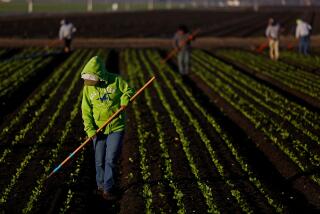A calendar for your crops
- Share via
Don’t pack up the vegetable garden after you’ve picked that last tomato or pepper. In most of Southern California there are vegetables for every month. A few, including lettuce, carrots, beets and radishes, sprout and grow almost anytime, though the seed might take a little prompting during the hottest or coldest weather. Others grow in one of our two gardening seasons — during the warm weather of spring and summer, or the cool months of fall and winter. You simply need to know what to plant when.
For instance, cauliflower, broccoli and the other cole crops grow only during cool weather. You could be planting these as we speak, but you could also plant anytime in autumn. Peas are another vegetable that prefers cool weather, while their cousins, the many kinds of beans, favor warm. Most of the popular crops do best in warm weather, such as corn and cucumbers, squash, eggplant, melons and peppers. And, of course, the tomato and its friend the tomatillo.
Some gardeners actually prefer growing the cool-season vegetables because they are generally easier and have few pests and diseases. It’s also easier to keep them watered since the sun is lower and days are cooler. Rains often do all the irrigating. Weeding remains a big chore, though the weeds are different than those of summer: They too have their seasons.
Winter vegetables tend to take up less space in the garden than the vines and bushes of summer, and the four mentioned above — lettuce, carrots, beets and radishes — are perfect for those with little garden space. Not only do they grow in almost any month, but they are small and fit handily in raised beds or even big pots.
Seasons sometimes overlap. A vegetable such as broccoli may need warm weather to sprout, but must ripen in cool weather or the crunchy florets will bloom too quickly and go over the hill. For this reason, it may be planted in the heat of August for a cool fall harvest.
Serious vegetable gardeners keep track of when they plant and when they harvest and, with time, learn the best times for each vegetable. They’ve been doing this for more than 150 years in Southern California, and there are planting guides based on what they and commercial farmers have discovered. The information below has been gleaned from a number of these planting guides, some quite old, others recent.
Whenever you plant, it’s a good idea not to do it all at once. Sow some of the seed from a packet, then wait two to three weeks and sow a little more. This will guarantee that not all the carrots or squash ripen at once and that the long growing season turns into a long, bountiful harvest.






